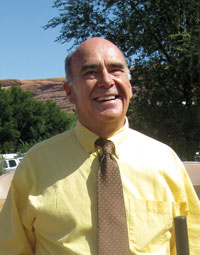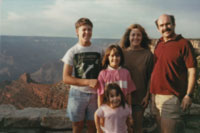INNOVATIVE HAPPENINGS JULY 2012 |
Kyle Bailey
|
 “I could have gone to Elko when the uranium business moved out of the U.S. and, hence, Moab. That was 1982-83, but my family and I decided to stay.” Thus, Kyle Bailey starts recollecting how he and his family survived the bust and went on to thrive in Moab. “I had been working for Atlas Minerals as assistant purchasing agent. Moab’s population shrank by 25% in 1983. A house that had been selling for $50,000 was selling for $25,000, if at all. Without jobs, people were just walking away from their homes.” The question was how would Kyle and his wife Carrie support themselves and kids in Moab? “I could have gone to Elko when the uranium business moved out of the U.S. and, hence, Moab. That was 1982-83, but my family and I decided to stay.” Thus, Kyle Bailey starts recollecting how he and his family survived the bust and went on to thrive in Moab. “I had been working for Atlas Minerals as assistant purchasing agent. Moab’s population shrank by 25% in 1983. A house that had been selling for $50,000 was selling for $25,000, if at all. Without jobs, people were just walking away from their homes.” The question was how would Kyle and his wife Carrie support themselves and kids in Moab?They started by opening a video store with Dave Sakrison on the corner of Center and 100 East where Pantele’s is now. A couple of years later, Kyle and Carrie bought out Dave continuing with the business into the early 1990’s. Over the years, besides renting videos and VCR’s, they sold candy (the first Jelly Belly I tasted was from their store) and fresh ground coffee and whole beans. They opened a Western Union Office and UPS Store. For a while, they and Diane Tibbets also had a toy store in the Energy Building.  When they closed the video store in the 1990’s, they bought an apartment building on 100 South. During the boom, there had been many apartments in Moab rented to prospectors, miners, millers, haulers and everyone else connected with the uranium industry. When they left, those places fell into disrepair. Kyle describes the eight-plex as “half rented, and the rest ready to cave in. We remodeled and started nightly rentals with kitchenettes.” Thus, the Cottonwood Condos were born. The Baileys later purchased a four-plex on 100 East, remodeling to create the Fandango Guesthouse. When they closed the video store in the 1990’s, they bought an apartment building on 100 South. During the boom, there had been many apartments in Moab rented to prospectors, miners, millers, haulers and everyone else connected with the uranium industry. When they left, those places fell into disrepair. Kyle describes the eight-plex as “half rented, and the rest ready to cave in. We remodeled and started nightly rentals with kitchenettes.” Thus, the Cottonwood Condos were born. The Baileys later purchased a four-plex on 100 East, remodeling to create the Fandango Guesthouse. Kyle talks about how “the community as a whole got behind tourism as our primary industry. Betty Stanton was the power house behind the Grand United Front (GUF) which included the film commission, river companies, then the bicycle shops and other tour companies.” GUF worked to make Main Street more tourist oriented. The Super Host Program was developed as part of this push, training clerks, food servers, and motel staff to meet and talk to tourists, especially foreign. It was a huge success. Kyle says he “was always involved in politics”, but his involvement took a formal turn when he ran for mayor in 1985. He lost that race, but Tom Stocks, who won, asked him to be on the City Planning and Zoning Commission. He served on the commission for 12 years and chaired it for 10 of those. The planning commission and city council brought in students from Utah State University to help design a plan of action. As a result of that and other information gathering, Kyle lobbied for a city planning department. The City hired David Olsen whose first major project was designing and building the Moab Parkway. Kyle’s next move in politics took him to the City Council. He is serving his fourth term and still focusing on planning including economic development. “I’ve always encouraged home businesses and small businesses, and now there are more opportunities for those than 15 or 20 years ago.” Asked what he is most proud of during his years on the commission and council, Kyle said, “I’m probably happiest about the part I played in getting the Parkway developed.” Another important project for Kyle has been the Moab Area Partnership for Seniors. “We purchased 20 acres from Collin Fryer for the Senior Center. We then worked to get the long-term care facility built, so seniors could stay in the community. There were 14 extended care beds in the old Allen Memorial Hospital, and 36 in the new Moab Regional Hospital.” Mayor Dave Sakrison says, “Kyle was instrumental in getting the new extended care facility.” The Senior Center is owned by Canyonlands Special Service District (CSSD) another board Kyle serviced on. He is now on the hospital board and serving as liaison to the CSSD board. These facilities--the hospital and extended care unit--not only serve a critical health care need, but they also keep money in the community and provide good paying jobs for some 150 people. As Kyle says, this kind of job creation is at the heart of community development, but community development doesn’t just happen. Again quoting Mayor Dave, “Kyle is the most active member of the council I’ve ever served with. He is the quiet one that goes about the business of the City. He is a very good man.” Moab City has not suffered in the recent recession like so many towns. It wasn’t necessary to lay off any employees. This is, in part, due to the attractiveness of the community as both a tourist and a retirement destination. While we haven’t boomed in growth like some Utah communities, we haven’t had a bust since 1983, either. We can thank Kyle and those like him who serve selflessly on the city and county councils, commissions and boards for this. “Moab”, as Kyle says, “has its faults, but it is still the best place to live. The diversity here makes us a unique and healthy community.” People in Moab are vocal which is actually another measure of a healthy community. Kyle recalls one of the times when a heated debate eventually resulted in county citizens coming together to stop the construction of a toxic waste incinerator at Cisco in 1988. If it had happened, I-70 would have been a major corridor for toxic waste, and Grand County would be a different place to live than it is today. Community isn’t about always agreeing on the best course of action. It is about dialogue, the respectful exchange of ideas. As Kyle says, “People can still come to Moab, get involved, and make a difference.” |